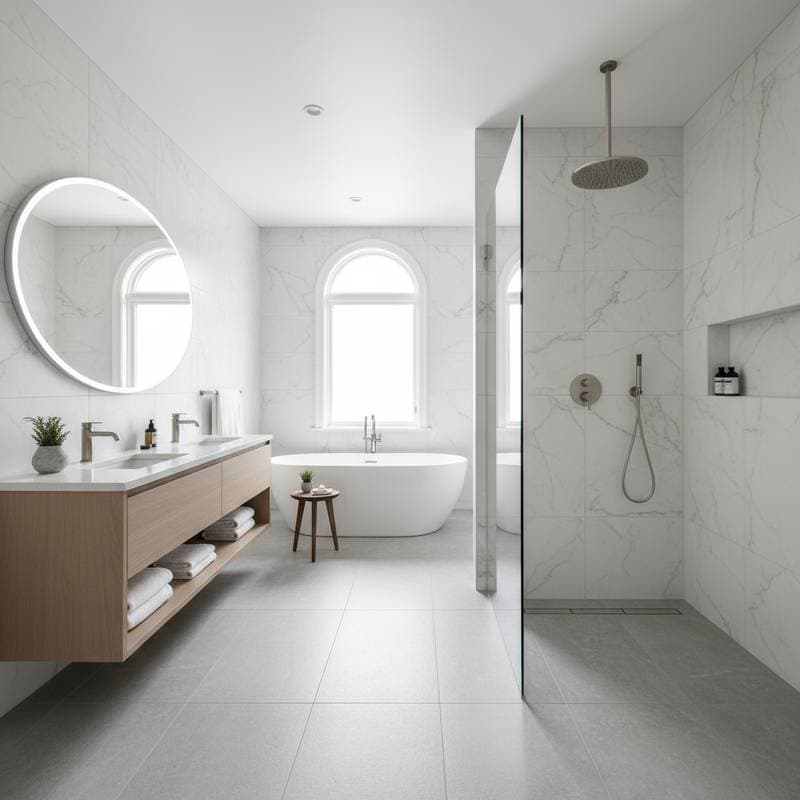Understanding Wet Rooms and Their Appeal
Wet rooms represent a seamless integration of shower space into the bathroom floor, eliminating traditional shower trays or curbs for a fully waterproof environment. This design choice creates an open, spacious feel that aligns with modern aesthetics and functional living. Homeowners appreciate the ease of cleaning and the absence of barriers, which contribute to a sense of luxury and practicality.
The rise in popularity stems from evolving buyer preferences toward minimalist, adaptable spaces. Unlike conventional bathrooms, wet rooms utilize sloped floors and specialized drainage to manage water flow efficiently. This setup not only enhances visual flow but also supports aging-in-place modifications, making homes more versatile across life stages.
The Impact on Home Value
Real estate analyses for 2025 indicate that properties with wet rooms command an 11 percent premium over comparable homes without this feature. This boost arises from the perceived modernity and convenience, which attract a wider pool of buyers in competitive markets. Agents note that such upgrades signal thoughtful investment in quality and style, often shortening time on market.
Beyond aesthetics, the value addition ties to long-term savings. Wet rooms reduce mold risks through superior waterproofing and simplify daily routines, appealing to families and professionals alike. In urban areas with smaller footprints, the space-efficient design maximizes usable square footage, further justifying the uplift in appraisal figures.
Installation Costs and Timelines
Budgeting for a wet room requires consideration of materials, labor, and site-specific factors. Basic installations start at $14,000 for standard setups, while premium options with custom elements can reach $28,000 or more. These figures include demolition, waterproofing, tiling, and fixture integration, assuming no major plumbing relocations.
Timelines vary from four to eight weeks, depending on project scope and contractor availability. Simpler retrofits in existing bathrooms may conclude in three weeks, whereas new builds or extensive remodels extend to two months. Factors like permit processing and material sourcing influence these durations, so early planning proves essential.
Unless professional tiling and plumbing expertise exists, entrust this project to a licensed contractor. Their involvement ensures compliance with building codes and optimal performance, safeguarding the investment.
Design and Material Options
Selecting the right components balances aesthetics, functionality, and budget. The following table outlines tiered approaches to guide decisions.
| Level | Floor and Walls | Drain Type | Heating Option | Estimated Cost |
|---|---|---|---|---|
| Good | Ceramic tile with basic membrane | Round center | None | $12,000–$16,000 |
| Better | Porcelain tile with full tanking | Linear | Optional radiant | $17,000–$24,000 |
| Best | Stone or large-format tile with advanced membrane | Hidden wall | Smart heated floor | $25,000–$35,000+ |
Entry-level choices prioritize affordability with durable ceramics that resist wear. Mid-tier upgrades introduce porcelain for enhanced water resistance and linear drains for subtle integration. Top configurations feature natural stone or oversized slabs, minimizing seams for a polished look, paired with intelligent heating for comfort.
Maintenance Strategies
Proper upkeep extends the lifespan and preserves the investment's value. Regular attention prevents common issues like water damage or aesthetic decline.
Routine Care
- Wipe glass surfaces and floors after each use to avoid residue accumulation.
- Reseal grout lines every 12 to 18 months to sustain moisture barriers.
- Clean drains on a monthly basis to clear soap residue and debris.
Lifespan Management
A well-sealed wet room endures 20 to 25 years prior to significant refurbishment. Adhering to resealing schedules averts leaks beneath tiles, maintaining structural integrity.
Warranty Coverage
- Waterproofing membranes carry 10-year to lifetime protections, varying by manufacturer.
- Tile installations receive 1- to 5-year guarantees from contractors.
- Fixtures and drains offer 2- to 10-year warranties.
Retain all documentation, including receipts and permits, to uphold warranty terms and support resale claims.
Safety and Regulatory Considerations
Prioritizing safety during installation and use mitigates risks associated with water and construction.
Safety Gear
- Wear nitrile gloves and safety glasses when applying waterproofing materials.
- Use non-slip footwear on damp tile surfaces.
- Employ a respirator for indoor tile cutting or grinding activities.
Hazard Checks
- Disconnect power to nearby outlets before commencing work.
- Verify water shutoff valves operate correctly prior to fixture removal.
- Perform a flood test on drains before completing tile work.
Permit Triggers
- Relocating or installing new plumbing lines.
- Adding underfloor heating or electrical circuits.
- Altering subfloors or structural joists.
Professional Requirements
Projects involving electrical work near water sources, structural adjustments for barrier-free access, or major water line modifications demand certified professionals. Local inspectors typically require expert certification for final approvals.
2025 Market Trends
Wet rooms emerge as a prominent feature in both new constructions and renovations, distinguishing properties in buyer-saturated regions. Data from listings reveals that homes with curbless, open showers garner greater interest due to their promotion of spatial efficiency and lifestyle alignment.
Supply chains for specialized drains and imported tiles have stabilized, though custom glass elements may incur delays. Plan budgets with buffers and initiate orders promptly. Large-format porcelain panels rise in demand for their grout-free seams and fluid appearance, impacting both expenses and market desirability to sustain the 11 percent value increase.
Steps to Implement Your Wet Room
Initiate the process with a professional design consultation, costing $200 to $400. This session yields a detailed layout, including drain positions, floor gradients, and tile arrangements, to sidestep expensive revisions.
Engage reputable contractors through references and portfolio reviews. Request itemized quotes covering materials, labor, and timelines. During construction, monitor progress to ensure adherence to plans and safety protocols.
Post-installation, conduct a thorough walkthrough to confirm functionality. This upgrade not only elevates daily comfort but also secures future financial returns through enhanced property appeal and durability.








